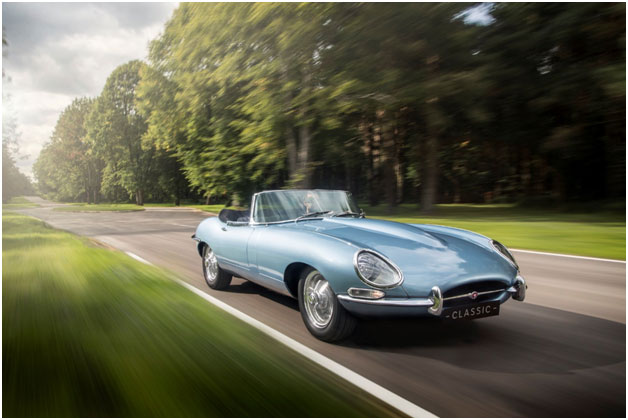
JAGUAR E-TYPE ZERO: jaguarcarsmena / flickr
Converting Classic Cars to Electric Vehicles is Shockingly Popular
There is a trend which is taking the classic car circuit by storm: converting these antique cars into electrical vehicles using the latest in modern technology.
However, this process has divided the vintage car community, as some see this juxtaposition of modernizing a classic automobile as a betrayal of the ideology behind restoring antique and collectible cars.
Despite the controversy, the number of these vintage car EV remodels continues to grow as more owners or classic car enthusiasts jump on the “green” bandwagon and take their antique cars to the next level.
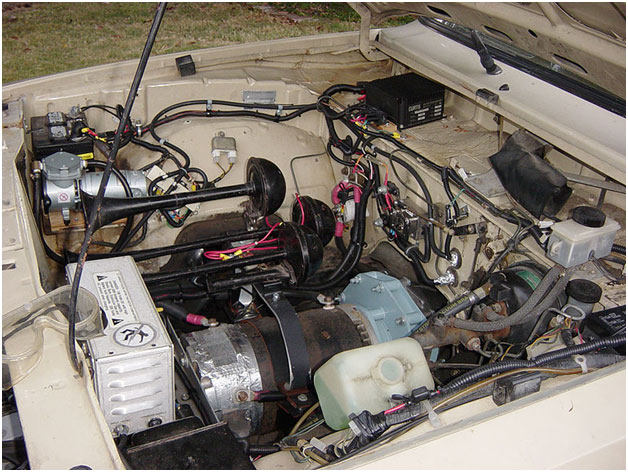
Image Credit: Leonard G. / Wikimedia Commons
Interest in EV Conversions Is on the Rise
What was originally a pet project for a few hobbyists is rapidly becoming a conversion industry.
As greater interest in reducing harmful emissions has taken root in the automobile industry, others are realizing the benefits of deviating from the combustion engine.
Antique vehicles emit significant quantities of harmful emissions, often billowing smoke, leading many owners to take the plunge into electric battery conversion.
So many people have engaged auto repair facilities to assist with this process that some of these centers have even begun to add additional training for their mechanics specifically to convert classic cars to classic EV cars.
Are Classic Cars Still Considered “Classic” If converted to EV?
This question is a matter of considerable debate in the vintage and collectible car community.
While there’s something exciting and awe-inspiring when viewing a sleek classic car exterior and then popping the hood to see an EV setup, many classic car organizations say that tweaking the vehicle this way, introducing modern technology, invalidates the car’s “classic” status.
This is because now the vehicle is more of a classic hybrid and while it looks like an antique vehicle, it’s more like a wolf in sheep’s clothing because the innards have been replaced with top-of-the-line technology.
Many of the antique car agencies will only consider a car classic if its makeup consists solely of time era specific parts for the era in which the vehicle was manufactured.
In other words, if a part fails, it’s acceptable to find a replacement from antique stock, just as you might have done if you had the same part failure at that time in history. Upgrading with anything beyond this time window is considered cause to revoke your collectible car’s antique status.
The Arguments Against Vintage Car Conversion
Those who stand against the EV conversion process often find it offensive to “contaminate” an antique by introducing new craftsmanship, perhaps the way an art-lover might view a modern artist making modifications to a classic portrait.
In their eyes, it devalues the historical aspect of the vehicle and destroys a part of its authenticity every time someone makes the conversion.
Others are more upset at the loss of certain key features of classic cars which are a large part of what make these vehicles fascinating and enjoyable.
To make the conversion, a significant amount of modification is required to accommodate an electric battery. Furthermore, the elimination of the combustion engine means that the traditional loud rumble of that engine is gone, which for some traditionalists, means the heart and soul of the antique car has gone with it.
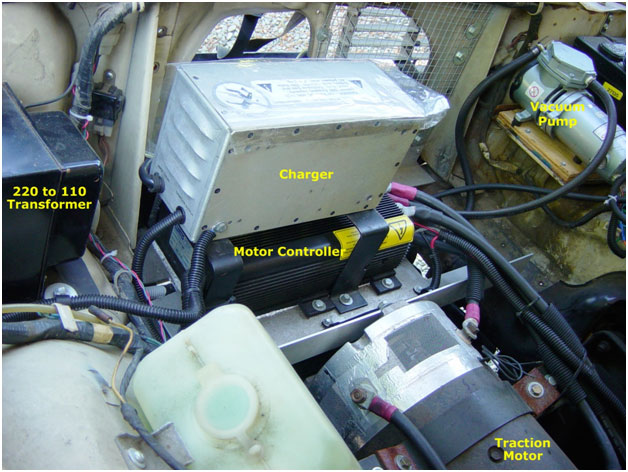
Image Credit: Leonard G. / Wikimedia Commons
Elements of a Conversion
Obviously, the greatest change is the replacement of the combustion engine with an electric battery. That is a big change but doesn’t seem like that big of a deal.
Yet, the electric battery is so hefty it adds about 1,000 pounds to the weight of the car, which means that to accommodate that weight, there must be modifications made to the suspension, brakes, steering, and many other internal aspects of the vehicle for it to function properly.
While any vehicle can theoretically be converted to an EV, because of the significant weight addition, lighter vehicles are often chosen for the process since there will be a lower overall weight to counterbalance than with a vintage car which is already substantial.
Here are some other aspects of the conversion process:
- The overall body needs to be restored first if damaged
- The lighter the car, the longer the battery charge will last
- As well as the battery, you will need to install the charger
- A power controller and electric throttle is necessary to regulate energy flow
- Power conductors
- Circuitry to connect the components
- Conductors to join the battery, controller, and motor
- Additional equipment to power brakes and heating
- Operation and maintenance parts
At this point, that requires a lot of work and a significant amount of alteration to the antique vehicle, which is why so many vintage enthusiasts frown upon this transition process.
Electric Car Conversion Industry
One of the major reasons that many people seek a streamlined process of converting older vehicles is because when these automobiles become defunct, they typically are scrapped, and the remains sent to a landfill to waste away.
Rather than see that happen, many would rather find a way to reuse these vehicles, even if it may violate the integrity of its “classic” status. Making conversions breathes new life into old vehicles by giving them the technology needed to prolong their lives and keep them out on the roads.
The conversion process is anything but cheap. As the need to convert existing automobiles to EV is growing, however, there are those working to streamline the process, cutting down on the expense.
These conversion industry advocates expect that in the future, there will either be kits available which make it easy to quickly perform a conversion at less expense or at least enough demand that the process itself becomes a smooth transition, which will also result in savings.
One of the largest concerns is that EV batteries themselves (not even considering all the supplemental parts required) are very expensive, and since vintage cars are not designed to be light enough to maximize electric mileage, a high-end battery is required to get enough to even make the conversion feasible.
Yet, the EV industry itself is booming and as consumers turn to electric vehicles, the parts will gradually decrease in price to the point where it will be possible for typical citizens to afford to make conversions to existing vehicles.
That will eventually make the conversion considerably cheaper than purchasing a new vehicle, which adds credence to the power of recycling a vehicle in this way.
Plus, many hobbyists love classic cars because they look unique and stand out, where new vehicles tend to look pretty much the same. Having the potential to get these antique rides out on the road, fully functional and environmentally friendly, would be a great spectacle, allowing everyone to enjoy a glimpse into the past.
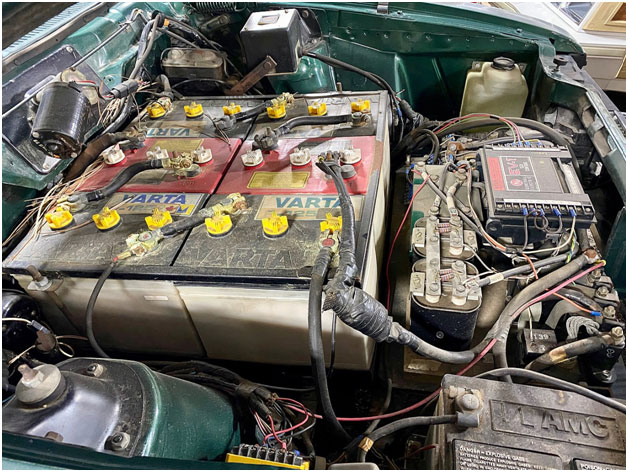
Rambler Ranch collection in Elizabeth, Colorado: CZmarlin / Wikimedia Commons
Hobbyist Conversions
Many hobbyists understand that antique parts are limited and that older vehicles tend to get scrapped when their usefulness ends. A lot of these enthusiasts stand behind conversion as a means of preservation, as converting these automobiles with modern technology will extend their lives and usefulness.
Rather than fossilizing these historical vehicles in a museum, it allows restoration which puts the vehicles to use again, giving them the chance to live again on the roads and keep this part of the past alive.
True, the distinctive sound of the engine will be gone, but there will always be combustion engines preserved for those who want to experience that for themselves. In the meantime, these classic car remodels can reinvigorate the past and entice new hobbyists to learn about these cars.
While the expense to convert them right now is great, there are more affordable options if the hobbyist is willing to sacrifice the vehicle range. Short-range battery electric vehicles are about half the size of the standard model, which means a lot less modification is necessary to make the automobile functional.
While this saves on expense, it means that the vehicle may only get around 30 miles on the charge, but this is functional for driving about in a typical neighborhood.
At the very least, it’s an option until the industry develops and prices drop, including those of the technology itself.
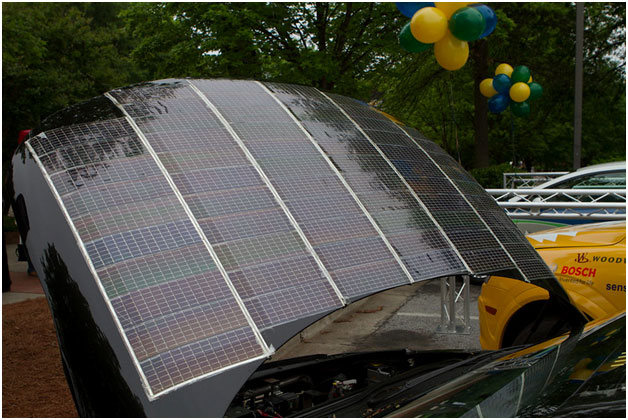
Image Credit: John Ramspott/ flickr
Solar Power
A handy complement to your electric battle would be solar power paneling. The inclusion of these as a modification is a viable way to charge your EV’s battery.
As solar power technology becomes cheaper and more accessible, it has become an important source of energy production for many people. Some use these panels to provide energy to their home, which can in turn be used to charge an EV.
In fact, even a small system of 10 panels can be enough to charge your electric vehicle’s battery.
Some companies are developing solar panels on the cars themselves, which allow your vehicle to charge as you drive, presuming of course that you have sunlight available.
While the charge provided by this process is not as significant right now as one may hope, improvements and developments in the field of EV solar panel technology will undoubtedly become a significant part of the EV model for the future and will become more relevant.
These companies are functioning with the goal of eliminating the need to plug in your EV at all, using ultra-thin solar panels on the vehicle itself and attempting to improve the technology enough that those panels can successfully provide all the energy your ride needs.
It will be interesting to see what the future of this solar panel and EV model will bring.
The Conversion Process
When planning to make the conversion from classic car to a modern classic, the first consideration is, of course, the car in question. The weight of the vehicle is a major factor and determines how much additional work is necessary for the automobile to support the electric battery.
Next, the process of removing the entire internal combustion engine begins, and providing the support and modifications needed to sustain the heavy battery. Once those preparations are made, the electric battery itself is installed and all the connections made to ensure that the energy flow is functioning properly, and that the vehicle functions up to code.
That means that it will need to be inspected by a vehicle safety engineer to ensure that the vehicle is safe for use. Once the vehicle passes inspection, then it is ready to go.
An advantage of the process is that electric batteries tend to have a very long lifespan and are often salvaged from any EV car accidents in which the vehicle is totaled, for reuse.
Plus, the benefit is that you now have a vehicle that does not emit harmful emissions and is powered by electricity, which can save a considerable amount of money.
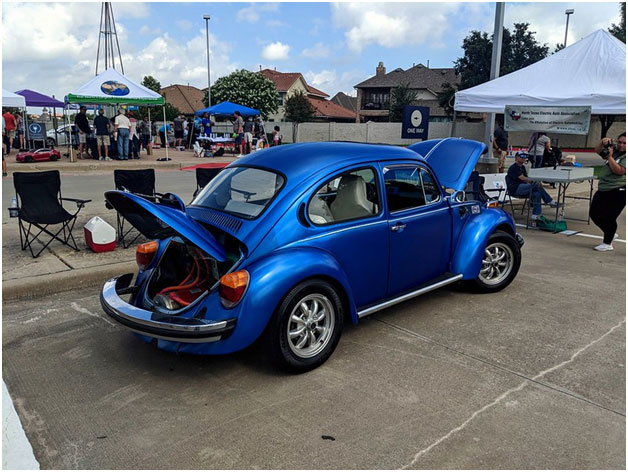
Image Credit: Steve Rainwater/ flickr
Which Cars Are Best to Convert?
The best antique cars for EV conversion are those which are lighter, as it means that your battery will perform better and provide more substantial mileage than a heavier model.
Keep in mind, you will undoubtedly get significantly less mileage than a new EV because those cars are designed for optimum energy efficiency, whereas your classic car is from a completely different era.
Also, vintage cars from the 1980’s and 90’s tend to be the goldilocks zone, as they feature more improved technology which facilitates easier and cheaper conversion, while including limited computerized circuitry to override when installing modern technology.
That makes those vehicles more cost effective and easier to convert than older or newer models.
What Does This All Cost?
If you are seeking a longer-range vehicle that can maintain highway speeds and can make it over 100 mph on a single charge, it’s not going to be cheap. Expect to pay over 30K to achieve your classic EV dream.
In fact, in many cases, the cost of converting a classic vehicle to an EV is about the price you would expect to pay for a new EV! However, for many hobbyists, it is worth it to have a modern vehicle that for all intents and purposes, is a fully functional antique vehicle which stands out from the cookie cutter newer models.
This price requirement is expected to significantly decrease as the conversion industry develops and the technology itself becomes less expensive.
Just don’t forget when factoring in your costs and budgeting, you will need to find your classic car insurance and will need to have materials available to repair and maintain your modified ride.
Yet, there’s nothing quite like having a classic car that you can drive and expect to last.
